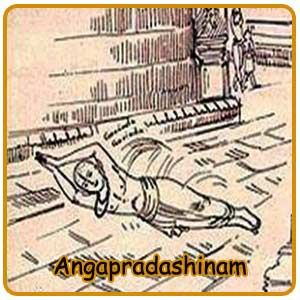Can Women Perform Anga Pradakshina?

- Dviyanga Namaskaram: Joining both hands and bowing.
- Triyanga Namaskaram: Bowing with both hands clasped and head lowered.
- Panchanga Namaskaram: Bowing with five body parts touching the ground – both hands, both knees, and the head.
- Sashtanga Namaskaram: Bowing with six body parts touching the ground – both hands, both knees, the head, and the stomach.
- Ashtanga Namaskaram: Bowing with eight body parts touching the ground – both hands, both knees, the head, the stomach, shoulders, and ears.
- Sangopanga Namaskaram: Bowing with all body parts and any objects being held falling to the ground, similar to a tree shedding its branches, leaves, flowers, and fruits.
All of the above namaskarams can be performed by men. However, women are not prescribed to perform Sashtanga, Ashtanga, and Sangopanga Namaskarams.
Ekanga Namaskaram: Bowing with one hand or just bending the body to bow is not prohibited for anyone at any time.
In royal courts and temples, one should not bow to the guru. In the royal court, only the king is worthy of respect, and in the temple, only the deity is to be revered. An exception is made during the Acharya Utsavam in temples.
According to the Smritis (ancient texts), the waist, the holy womb, and the breasts, which are part of motherhood and serve to conceive, carry, and nourish the child, should never touch the ground. They should not bow to anyone, as motherhood is always worthy of reverence.
Additionally, books, the tongue of a bell, the stomach of a conch, and the pitham (seat) of a priest conducting rituals in the house should not touch the bare ground. Women should not lie face down.
Anga Pradakshinam is a traditional form of worship practiced by the matrilineal communities and hence specific rules regarding it are not mentioned in religious texts. However, considering the reverence for motherhood, it is understood that women do not perform Anga Pradakshinam.
In the Eelam Shaiva tradition, women have never performed Anga Pradakshinam. There is a custom of worshipping by performing Panchanga Namaskaram for every step or every three steps, known as “Aadi Azhithal”. Tibetan Buddhists on their Kailash pilgrimage also practice this type of circumambulation around Mount Kailash.
4o









